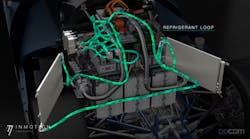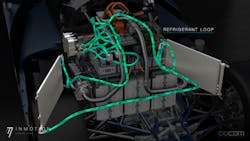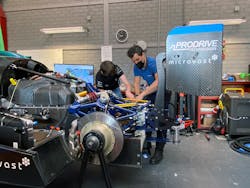READ MORE: Extreme Fast Charging: Revving Up the Electric Vehicle Era
InMotion, a team of students from Eindhoven University of Technology in Netherlands, is developing an all-electric race car, The Revolution, it hopes will be the first electric car to run in the 24 Hours of Le Mans endurance race. One of the challenges the team faces is developing a fast-charging capability, dubbed “Electric Refueling,” that will work with the higher-voltage batteries being developed to give the car better performance and range and make the battery-powered racer a viable competitor.
One aspect of that challenge is to minimize heat build-up in The Revolution’s 58-kWh battery during recharging, efficiently cool the battery pack and incorporate quick battery disconnect hardware. It is hoped that such a new recharging approach could be used on consumer vehicles and make electric vehicles more attractive to consumers.
The student team is partnering with PowerFlex, a sponsor based in the Netherlands with expertise in hydraulics, including hoses, couplings, components and accessories. To improve the chances for success, PowerFlex enlisted Danfoss.
READ MORE: Delivering True Wireless Charging From a Distance
The high currents needed for fast recharges means the battery pack heats up when recharged. To prevent this scenario, which can lead to damage to the car and harm to the driver, the InMotion team had to add a liquid-cooling subsystem. If the battery pack is not cooled, the charging currents must be reduced, resulting in longer charging times.
“The cooling system consists of two separate loops and is powered by the battery pack,” says Stijn van de Werken, technical manager at InMotion. “The first loop extracts heat from the pack during recharging and driving, and carries it away as a heated fluid—a mix of water and cooling liquids. The second fluid-filled loop extracts heat from the first loop. The now-warm fluid in the second loop travels to radiators in the car’s sidepods to be cooled by airflow. And because this refrigerant approach uses the same working principles as an air conditioner, the battery pack can be cooled below ambient temperature.”
Generally speaking, the car’s lithium-ion cells should only be charged when they are between 5° and 45°C, the temperature range in which currents can flow as fast as possible. If their temperature exceeds this, the battery can be irreversibly damaged and lose capacity. So, on The Revolution, if this temperature limit is reached, the charging current is reduced, or charging is stopped.
How much power the cooling system uses depends on the ambient temperature: The colder it is, the less power is needed. And the less power it uses, the more there is available to increase the car’s performance and range.
READ MORE: Solid-State Batteries for EVs: The Key to Long-Distance Driving?
The cooling system makes widespread use of Danfoss’ EverCool GH001 multi-refrigerant hose and fittings. The hose features near-zero permeation, a tight bend radius and compatibility with many refrigerants. It also withstands the widest range of temperatures of hoses in its class.
To install the hoses, the InMotion team chose Danfoss EZ Clips. They are vibration and impulse tested to perform in demanding applications, and are easy to install even in tight spaces with minimal connection points. The clips also eliminate the need for costly crimping tools.
To improve safety and ease of maintenance the car’s designers specified Danfoss Hansen aluminum dry-break ADB quick-disconnects for connecting and disconnecting the battery. If an accident during a race damages the battery pack, other electrical components in the car can also be damaged; this makes it critical to quickly disconnect the pack. The quick disconnects also let technicians safely work on the car without disconnecting actual high-voltage cables or wasting time. For safety, the disconnects are opened when the car is not being driven to reduces the risk of accidents.
“EZ Clips consist of three components, a cage and two clips. The cage holds the hose tightly to the fitting, preventing it from being pulled off,” says Dimitar Atanasov, a global product management leader for Danfoss Power Solutions. “And the clips’ no-spill, flat-face design make them well suited for The Revolution race car, where any fluid leaks—even plain water—could cause technical issues among the electrical components.
“We have deep experience with Danfoss products and they are always our preferred choice when it comes to applications where performance is absolutely critical,” says Jop van der Wal at PowerFlex. “They offer a low weight-to-power ratio, high performance and racing-level quality. The components were designed for exactly this kind of challenge—and they delivered.”
Thanks to PowerFlex’s expertise and the high-quality Danfoss hoses and fittings, InMotion’s prototype race car battery pack can go from near depletion to 80% of a full charge in 12 min. They also make it easier for the InMotion design team to assemble or reconfigure the cooling system.
PowerFlex and Danfoss engineers, together with the InMotion team, are now working on a next-generation battery pack/cooling system to shorten the charging time to just a couple of minutes.
The team plans to run The Revolution in several short races to test its designs and validate the underlying engineering concepts. Once they are all checked out, The Revolution will be ready to take on Le Mans.



